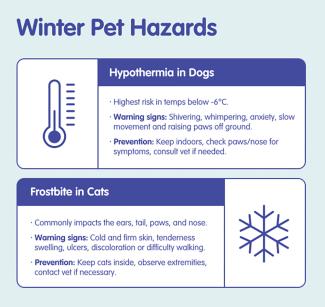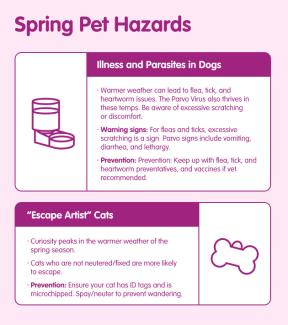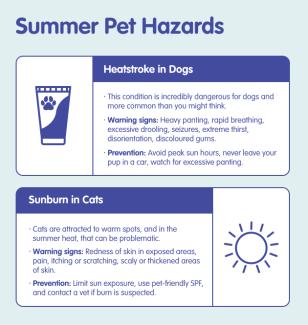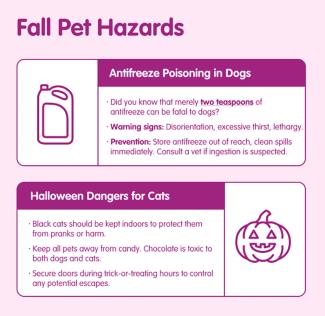Seasonal Safety for Pets: Navigating Year-Round Hazards
As the seasons change, so do the needs of our furry family members. Keeping pets safe and healthy year-round requires awareness and adaptation to seasonal hazards. Whether it's the biting cold of winter, the unpredictable weather of spring, the scorching heat of summer, or the hidden dangers of autumn, each season presents unique challenges for pet care.
This guide is dedicated to helping pet parents navigate these changes with ease, ensuring their beloved pets enjoy every season in safety and comfort. Let's explore how to best protect our four-legged companions throughout the year.
Winter Woes: The Challenging Chill

Winter's here! And with falling temps come some hidden and not so hidden cold weather hazards. Are your pets safe?
When it comes to dogs, hypothermia is a real threat. Watch for signs like shivering, anxiety, limping, and sluggishness, and don’t allow them to stay outside when the degrees drop down low if their body and coat type aren’t suited to it. They may love the snowy tundra, but if they’re not built for the cold, it’s for their own good to keep them warm and safe indoors.
For our feline friends, frostbite is no joke, especially on their vulnerable ears, noses, and paws. Prevent severe injury by keeping your cat indoors and vigilantly monitoring them for any signs of discomfort.
Some common symptoms of frostbite in cats include:
- Cold and firm skin
- Tenderness
- Swelling
- Ulcers
- Discoloration
- Difficulty walking
Even if you’re not a pet owner yourself, remember to always use pet-friendly salt for winter walks. Regular ice-melting salts can be harmful to pets. They can irritate paws, leading to dryness, cracking, or even burns. Additionally, if pets lick their paws after walking on salted surfaces, they can ingest harmful chemicals, which may lead to health issues like gastrointestinal upset or more serious conditions.
Pet-friendly salt is formulated to be safer for animals, reducing the risk of paw irritation and toxicity, ensuring a safer environment for pets during winter.
Springtime Struggles: Warmer Weather, More Worries

Spring brings a wave of new adventures and, along with them, some health concerns for our beloved pets. As the world awakens from its winter slumber, it's crucial for pet parents to be vigilant about spring-specific diseases and conditions that can affect our dogs and cats.
For our energetic dogs, who might be relishing the thawed outdoors, keep an eye out for signs of common springtime ailments:
- Increased Exposure to Parasites: Warmer weather can lead to a surge in fleas, ticks, and heartworms. Watch for excessive scratching or signs of discomfort.
- Parvo Alert: This highly contagious virus thrives in warmer temperatures. Symptoms include vomiting, diarrhea, and lethargy.
- Allergies in Bloom: Just like humans, dogs can suffer from seasonal allergies. Sneezing, itchy skin, and ear infections might indicate an allergic reaction to pollen.
If you notice any of these symptoms, a trip to the vet is a wise step. Prevention, through regular checkups and vaccinations, is key to keeping your dog healthy and happy.
As for our curious cats, springtime curiosity can lead them into some risky escapades:
- Roaming and Mating Season: Unspayed or unneutered cats may feel the call of the wild more strongly in spring. To prevent unwanted litters and keep your feline safe, consider spaying or neutering, and keep a close eye on potential escape routes in your home.
- Outdoor Hazards: Cats exploring outdoors can encounter parasites and other dangers. Regular parasite control is essential, especially for outdoor adventurers.
And speaking of outdoor adventures, let's talk about keeping your garden pet-friendly. While many pet owners opt for natural options like diatomaceous Earth to protect their plants from pests, it's important to use such products wisely. While food-grade diatomaceous Earth is generally safe, it can irritate the eyes and respiratory system if inhaled. Ensure your pets aren't digging or frolicking in treated areas to avoid any potential risks.
Spring is a season of joy and rejuvenation, but it also calls for a bit of extra vigilance in pet care. By staying informed and proactive, you can ensure that your pet enjoys the season safely and healthily.
Summer Strains: Heat and High Risks

Summer means fun in the sun, but it’s not without risks. Dogs can suffer from heatstroke – yes, it's as scary as it sounds, with heavy panting and thirst being key warning signs.
Brachycephalic (short-nosed) dogs in particular have an increased risk of heatstroke in summer. Due to their facial structure, they often have breathing difficulties, which can be exacerbated in hot weather. Their compromised airways make it harder for them to regulate their body temperature through panting, which is the primary way dogs cool themselves.
All dogs can suffer from heatstroke if they’re exposed to high temperatures long enough. Avoid strenuous exercise and limit outdoor exposure. Our dogs may also get dehydrated, especially the extra active ones doing zoomies around the yard.
It’s also crucial to never leave your dog or cat unattended in a parked car, especially if the engine is off. Temperatures inside can soar to fatal levels within minutes, and in many states it’s illegal to do so.
For our sun-loving cats, especially the light-colored or “naked” ones, sunburn is a real thing. You can monitor for red exposed skin, scaley or blistered extremities, and itching or scratching. Remember, a little shade and lots of fresh water go a long way. Plus, don’t forget the pet-friendly sunscreen!
Autumn Alerts: Hidden Dangers in the Fall

As we fall into autumn, watch out for antifreeze poisoning in dogs – it's more common than you think. Many drivers prep for winter by topping off their levels of the stuff, and accidental ingestion can be fatal to pets. In fact, just 2-3 teaspoons can cause irreparable damage, even death. Always clean up after any spills and monitor for signs of:
- Disorientation
- Excessive thirst
- Lethargy
Cats aren't off the hook either; with Halloween around the corner, cat owners need to be even more diligent.
Halloween safety for cats is crucial due to increased risks during the festivities. Cats, especially black cats, should be kept indoors to protect them from pranks or harm. Decorations pose hazards; dangling ornaments can be tempting but dangerous for playful cats. Also, it's important to keep them away from candy, especially chocolate, which is toxic to both dogs and cats.
For both species, creating a quiet, safe space away from the Halloween commotion can help reduce stress and keep your furry friends safe and comfortable during the celebrations.
Year-Round Vigilance
Each season brings its own flavour, fun and of course, its own challenges. Staying on top of your pet’s health throughout the year means being vigilant and proactive. And hey, while we're at it, let's talk about pet insurance. It's not just about vet bills; it's about peace of mind, no matter the season.
